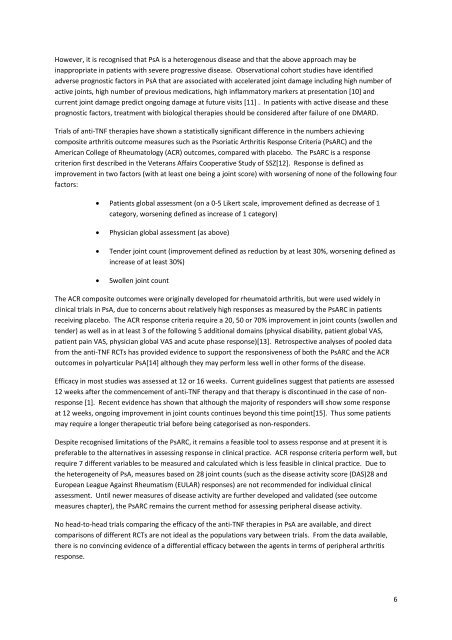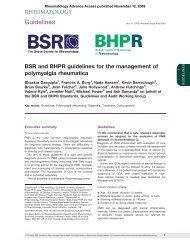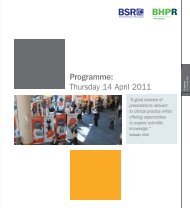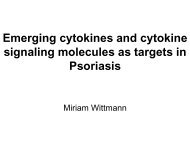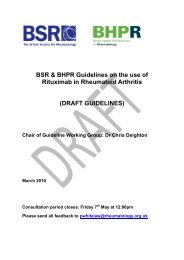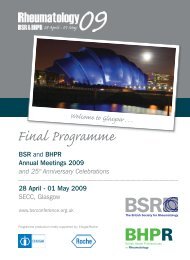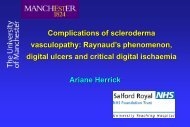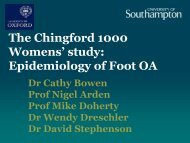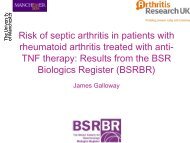Guidelines for the treatment of psoriatic arthritis with biologics
Guidelines for the treatment of psoriatic arthritis with biologics
Guidelines for the treatment of psoriatic arthritis with biologics
Create successful ePaper yourself
Turn your PDF publications into a flip-book with our unique Google optimized e-Paper software.
However, it is recognised that PsA is a heterogenous disease and that <strong>the</strong> above approach may be<br />
inappropriate in patients <strong>with</strong> severe progressive disease. Observational cohort studies have identified<br />
adverse prognostic factors in PsA that are associated <strong>with</strong> accelerated joint damage including high number <strong>of</strong><br />
active joints, high number <strong>of</strong> previous medications, high inflammatory markers at presentation [10] and<br />
current joint damage predict ongoing damage at future visits [11] . In patients <strong>with</strong> active disease and <strong>the</strong>se<br />
prognostic factors, <strong>treatment</strong> <strong>with</strong> biological <strong>the</strong>rapies should be considered after failure <strong>of</strong> one DMARD.<br />
Trials <strong>of</strong> anti‐TNF <strong>the</strong>rapies have shown a statistically significant difference in <strong>the</strong> numbers achieving<br />
composite <strong>arthritis</strong> outcome measures such as <strong>the</strong> Psoriatic Arthritis Response Criteria (PsARC) and <strong>the</strong><br />
American College <strong>of</strong> Rheumatology (ACR) outcomes, compared <strong>with</strong> placebo. The PsARC is a response<br />
criterion first described in <strong>the</strong> Veterans Affairs Cooperative Study <strong>of</strong> SSZ[12]. Response is defined as<br />
improvement in two factors (<strong>with</strong> at least one being a joint score) <strong>with</strong> worsening <strong>of</strong> none <strong>of</strong> <strong>the</strong> following four<br />
factors:<br />
• Patients global assessment (on a 0‐5 Likert scale, improvement defined as decrease <strong>of</strong> 1<br />
category, worsening defined as increase <strong>of</strong> 1 category)<br />
• Physician global assessment (as above)<br />
• Tender joint count (improvement defined as reduction by at least 30%, worsening defined as<br />
increase <strong>of</strong> at least 30%)<br />
• Swollen joint count<br />
The ACR composite outcomes were originally developed <strong>for</strong> rheumatoid <strong>arthritis</strong>, but were used widely in<br />
clinical trials in PsA, due to concerns about relatively high responses as measured by <strong>the</strong> PsARC in patients<br />
receiving placebo. The ACR response criteria require a 20, 50 or 70% improvement in joint counts (swollen and<br />
tender) as well as in at least 3 <strong>of</strong> <strong>the</strong> following 5 additional domains (physical disability, patient global VAS,<br />
patient pain VAS, physician global VAS and acute phase response)[13]. Retrospective analyses <strong>of</strong> pooled data<br />
from <strong>the</strong> anti‐TNF RCTs has provided evidence to support <strong>the</strong> responsiveness <strong>of</strong> both <strong>the</strong> PsARC and <strong>the</strong> ACR<br />
outcomes in polyarticular PsA[14] although <strong>the</strong>y may per<strong>for</strong>m less well in o<strong>the</strong>r <strong>for</strong>ms <strong>of</strong> <strong>the</strong> disease.<br />
Efficacy in most studies was assessed at 12 or 16 weeks. Current guidelines suggest that patients are assessed<br />
12 weeks after <strong>the</strong> commencement <strong>of</strong> anti‐TNF <strong>the</strong>rapy and that <strong>the</strong>rapy is discontinued in <strong>the</strong> case <strong>of</strong> nonresponse<br />
[1]. Recent evidence has shown that although <strong>the</strong> majority <strong>of</strong> responders will show some response<br />
at 12 weeks, ongoing improvement in joint counts continues beyond this time point[15]. Thus some patients<br />
may require a longer <strong>the</strong>rapeutic trial be<strong>for</strong>e being categorised as non‐responders.<br />
Despite recognised limitations <strong>of</strong> <strong>the</strong> PsARC, it remains a feasible tool to assess response and at present it is<br />
preferable to <strong>the</strong> alternatives in assessing response in clinical practice. ACR response criteria per<strong>for</strong>m well, but<br />
require 7 different variables to be measured and calculated which is less feasible in clinical practice. Due to<br />
<strong>the</strong> heterogeneity <strong>of</strong> PsA, measures based on 28 joint counts (such as <strong>the</strong> disease activity score (DAS)28 and<br />
European League Against Rheumatism (EULAR) responses) are not recommended <strong>for</strong> individual clinical<br />
assessment. Until newer measures <strong>of</strong> disease activity are fur<strong>the</strong>r developed and validated (see outcome<br />
measures chapter), <strong>the</strong> PsARC remains <strong>the</strong> current method <strong>for</strong> assessing peripheral disease activity.<br />
No head‐to‐head trials comparing <strong>the</strong> efficacy <strong>of</strong> <strong>the</strong> anti‐TNF <strong>the</strong>rapies in PsA are available, and direct<br />
comparisons <strong>of</strong> different RCTs are not ideal as <strong>the</strong> populations vary between trials. From <strong>the</strong> data available,<br />
<strong>the</strong>re is no convincing evidence <strong>of</strong> a differential efficacy between <strong>the</strong> agents in terms <strong>of</strong> peripheral <strong>arthritis</strong><br />
response.<br />
6


